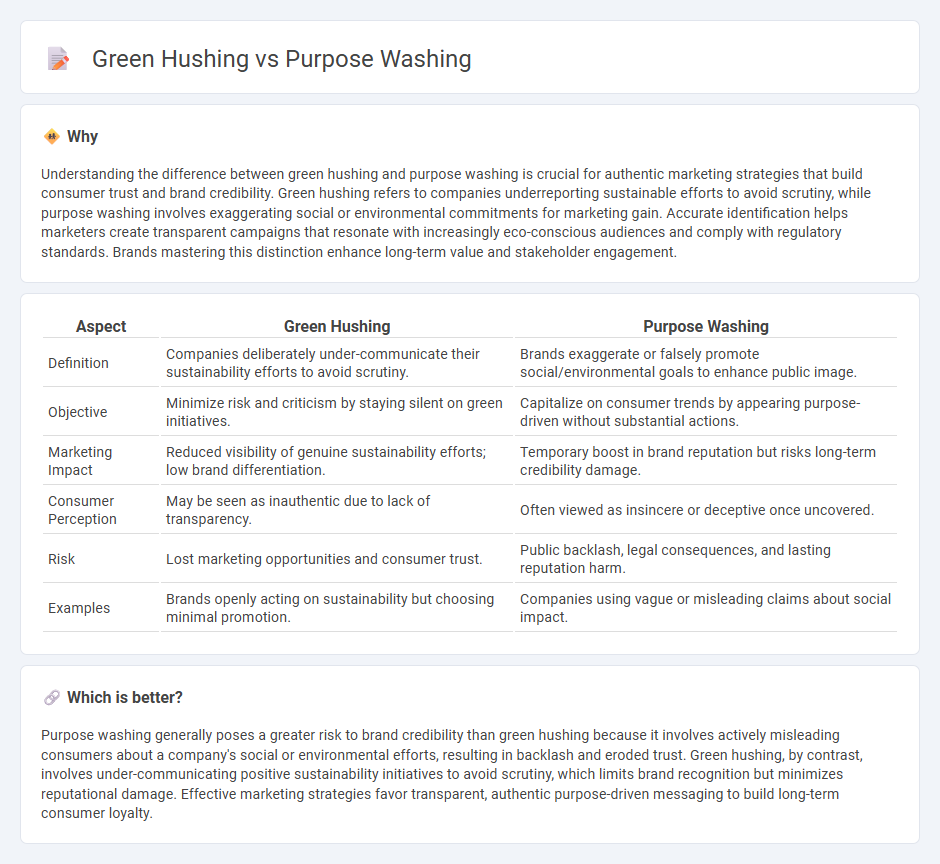
Green hushing occurs when companies underreport or minimize their environmental initiatives to avoid scrutiny or backlash, while purpose washing involves exaggerating or fabricating social and environmental commitments to enhance brand image. Both practices undermine consumer trust and distort the authenticity of corporate social responsibility efforts. Explore how businesses can navigate transparent marketing strategies to genuinely align purpose with performance.
Why it is important
Understanding the difference between green hushing and purpose washing is crucial for authentic marketing strategies that build consumer trust and brand credibility. Green hushing refers to companies underreporting sustainable efforts to avoid scrutiny, while purpose washing involves exaggerating social or environmental commitments for marketing gain. Accurate identification helps marketers create transparent campaigns that resonate with increasingly eco-conscious audiences and comply with regulatory standards. Brands mastering this distinction enhance long-term value and stakeholder engagement.
Comparison Table
| Aspect | Green Hushing | Purpose Washing |
|---|---|---|
| Definition | Companies deliberately under-communicate their sustainability efforts to avoid scrutiny. | Brands exaggerate or falsely promote social/environmental goals to enhance public image. |
| Objective | Minimize risk and criticism by staying silent on green initiatives. | Capitalize on consumer trends by appearing purpose-driven without substantial actions. |
| Marketing Impact | Reduced visibility of genuine sustainability efforts; low brand differentiation. | Temporary boost in brand reputation but risks long-term credibility damage. |
| Consumer Perception | May be seen as inauthentic due to lack of transparency. | Often viewed as insincere or deceptive once uncovered. |
| Risk | Lost marketing opportunities and consumer trust. | Public backlash, legal consequences, and lasting reputation harm. |
| Examples | Brands openly acting on sustainability but choosing minimal promotion. | Companies using vague or misleading claims about social impact. |
Which is better?
Purpose washing generally poses a greater risk to brand credibility than green hushing because it involves actively misleading consumers about a company's social or environmental efforts, resulting in backlash and eroded trust. Green hushing, by contrast, involves under-communicating positive sustainability initiatives to avoid scrutiny, which limits brand recognition but minimizes reputational damage. Effective marketing strategies favor transparent, authentic purpose-driven messaging to build long-term consumer loyalty.
Connection
Green hushing and purpose washing both relate to corporate communication strategies where companies obscure their true environmental and social impacts. Green hushing involves deliberately underreporting or concealing sustainable efforts to avoid scrutiny, while purpose washing exaggerates or fabricates commitment to social and environmental causes for reputational gain. These practices undermine consumer trust and challenge the authenticity of corporate social responsibility claims within marketing narratives.
Key Terms
Authenticity
Purpose washing erodes brand authenticity by superficially adopting social or environmental causes without meaningful action, leading to consumer distrust and reputational damage. Green hushing involves companies deliberately downplaying their sustainability efforts to avoid scrutiny, which can undermine transparency and stakeholder engagement. Explore effective strategies to balance genuine purpose-driven marketing with authentic communication.
Transparency
Purpose washing refers to companies exaggerating or falsely promoting their social and environmental commitments to appear responsible, often misleading stakeholders and consumers. Green hushing occurs when organizations downplay or hide their sustainability efforts to avoid scrutiny, criticism, or alleged greenwashing accusations, limiting transparency. Explore how businesses can balance honest communication with impactful sustainability initiatives for genuine transparency.
Reputation
Purpose washing inflates a company's commitment to social or environmental causes primarily for reputation enhancement, often leading to skepticism among consumers and stakeholders. Green hushing, by contrast, occurs when companies intentionally underreport or conceal their sustainability efforts to avoid scrutiny or criticism, which can undermine transparency and trust. Explore further to understand how these contrasting approaches impact corporate reputation management.
Source and External Links
Promises Have a Price: An Analysis of Higher Purpose - Purpose washing is defined as any communication that misleads people into adopting overly positive beliefs about an organization's higher purpose, evident in organizational performance, practices, products, or services.
Purpose-washing - Purpose-washing combines concepts of greenwashing and woke-washing, where companies claim to address societal needs without backing these claims with meaningful actions.
Purpose-led vs. Purpose-washing: What's the Difference? - Purpose-washing occurs when businesses talk about having a purpose but fail to back it up with meaningful actions, often leading to consumer distrust.
 dowidth.com
dowidth.com